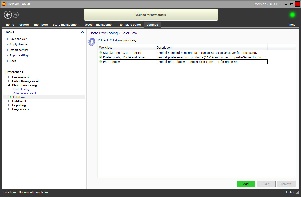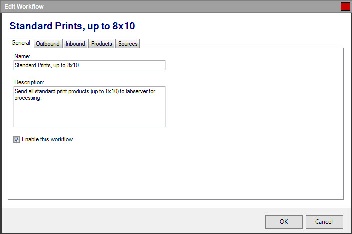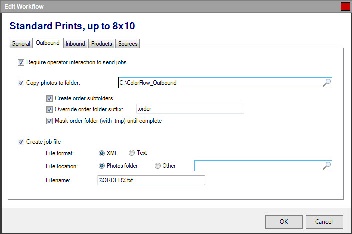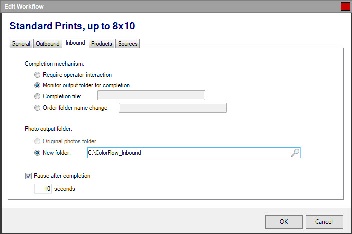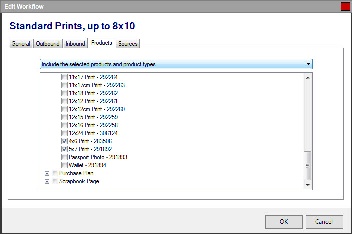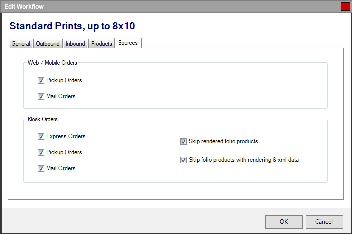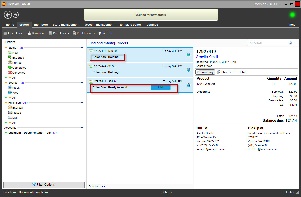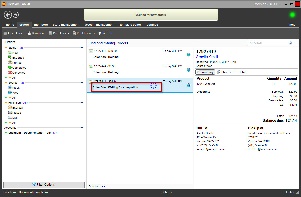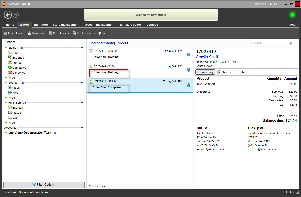ColorFlow allows you to correct and alter images prior to flattening/rendering into the product so you can color-correct images separately from the other elements of a creative project. You may still like to correct images in PJP or Fuji for prints, but for books, cards, calendars and the like ColorFlow is the answer. The products that it really has an impact on are collages (metal, canvas, etc), books, and calendars.
YouTube demo
The Basics
- Book order comes into Lab 50, you hit Print as you normally do.
- Images are sent from the book to the folder you designate.
- Your correction program either automatically or manual picks up images, you make the corrections then save them to a different folder.
- Lab 50 triggers and picks up corrected images, pulls them back into the book, flattens it the photos in with the text, background, and layout, and it goes to print.
Enable ColorFlow
Enable it on the Photo Processing screen in Lab 50:
- At the top of the Menu bar, select Settings.
- On the left panel select Photo Processing > ColorFlow.
- Check the box Enable ColorFlow processing.
Configure a new workflow for editing photos
- Click Add at the bottom of the right panel.
- On the General tab, enter a name for the workflow and check Enable this workflow.
- Name: A name for your new Workflow. This field is required. Lucidiom Support recommends a brief description of products included and/or sizing information. Example: Standard prints, up to 8x10
- Description: A description of the Workflow. This may be used internally to add additional identifying information such as where the photos will be stored or what type of processing will be done.
- Enable this Workflow: The check box enables the use of the Workflow for the selected settings. To temporarily disable a Workflow, un-check the box.
- For the Outbound tab, select how you would like the software to handle orders being sent through this workflow. Your choices are: export to a new folder, create order subfolders, and require lab operator interaction to start the ColorFlow processing in lieu of automatically exporting.
- Require operator interaction: If this option is checked, orders will not be sent through for ColorFlow processing until a lab operator manually clicks the SEND button. Please see the screenshot to the right captioned "Orders Queued for ColorFlow Processing" as an example of the on-screen notification.
- Copy photos to folder: This option makes a copy of the photos for the ColorFlow processing. This setting is generally recommended, otherwise the color correction will be applied to the original photos. If this option is checked, you'll need to enter the folder path to use for saving a copy of the order photos. You should enter the full path to the folder. You may use a local folder, mapped network drive, or network path as long as the user account has read/write access to the necessary folder. If the location for storage is on a networked computer, Lucidiom Support recommends using the UNC path to access the location to minimize connection issues. Example: _\\labserver\StandardPrints_
- Create order subfolders: To create individual order folders within your destination folder, check this box.
- Override order folder suffix: To change the order folder suffix (normally ".order"), check this box and enter the preferred suffix. Do not enter the '.'; for example, if you want the suffix to be ".colorflow", simply enter "colorflow" in this field.
- Mask order folder (with .tmp) until complete: Enabling this option will temporarily rename the order folder to xxxxxxx.order.tmp, where xxxxxxx is the order number, until all processing through ColorFlow is complete.
- Create job file : To create a file containing the order number and a list of all photos included in the order, check this box.
- File format: The job file may be formatted as XML or plain Text. Select the radio button that corresponds with your preferred formatting.
- File location: The job file may be output to the standard Photos folder within your Lab 50 configuration, or to another folder by selecting Other and entering a location. Lucidiom Support recommends that if you are including a job file that it is output to the same location as your photos folder specified under the "Copy photos to folder" location.
- Filename: The name to use for the job file. Macros that may be entered and substituted at runtime include %ORDER% to use the order number or %TIMESTAMP% to include the date and time.
- Under the Inbound tab, select how you would like Lab 50 to find the newly edited photos. The Inbound tab configures Lab 50 to find completed, ColorFlow-edited photos. Options include monitoring for photos in a new folder, checking for a folder name change, finding a completion file, or lab operator interaction indicating the editing is complete.
- Completion Mechanism:
- Require operator interaction: If this option is checked, orders will not be picked back up by Lab 50 after processing until a lab operator manually clicks the DONE button. Use this option when your ColorFlow workflow involves a manual color-correcting process, or the color station offers no automated way to indicate order completion.
- Monitor output folder for completion: Enabling folder monitoring will cause Lab 50 to continually monitor the inbound folder until it contains the same number of photos as were sent out for the order to begin with. If this setting is used, it is recommended that the "Pause after completion" option also be used, to ensure that the color station has time to finish copying the last photo into the folder before Lab 50 begins processing it.
- Completion file : If this option is enabled, Lab 50 will mark ColorFlow processing as complete as soon as the specified file exists. The file itself does not need to contain any data, and can be empty. The full path to the file should be specified, and the %ORDER% and %TIMESTAMP% macros can be used. For example, c:\ColorFlow_Inbound%ORDER%.order\done.txt.
- Order folder name change: If this option is enabled, Lab 50 will monitor the order folder and mark ColorFlow processing as complete as soon as the folder name is changed to match the entered name. A full path should be specified, and can include the %ORDER% and %TIMESTAMP% macros.
- Inbound photo folder:
- Original outbound ColorFlow folder: If your color correction will take place on the original files sent from Lab 50 (as configured in your Outbound tab settings) choose this option.
- New folder: If your color correction processing will output the edited photos to a new location, select this option. You should enter the full path to the new folder, and the %ORDER% and %TIMESTAMP% macros can be used. You may use a local folder, mapped network drive, or network path as long as the user account has read/write access to the necessary folder. If the location for storage is on a networked computer, Lucidiom Support recommends using the UNC path to access the location to minimize connection issues.
- Pause after completion: To add a delay between ColorFlow completion being recognized and Lab 50 continuing with its order processing, check this box and indicate the amount of time in seconds to delay. This setting is particularly recommended when the "Monitor output folder for completion" mode is used.
- Completion Mechanism:
- Using the Products tab, you will select which products to include or exclude from this Workflow. If you would like to process products differently according to product type, you will need to configure multiple Workflows.
- Include all products and product types: All products will be edited through ColorFlow using this Workflow configuration.
- Include the selected products and product types: Products that are checked in the box below the drop-down menu will be processed using this Workflow configuration.
- Exclude the selected products and product types: All products except the products checked in the box below the drop-down menu will be processed using this Workflow configuration.
- Lastly, the Sources tab is used to specify which order types should use the Workflow for processing. You can also elect to ignore products that have been rendered at the kiosk should you decide to not offer this premium editing service for in-store orders.The sources tab is used to specify which types of orders are processed through the ColorFlow Workflow. To enable an option, check the box next to the corresponding type. To disable an option, un-check the box next to the corresponding type. For more details on each type of order, see below.
- Web / Mobile Orders: This option includes any orders received from your Photo Finale website, iPhone application, or third-party API.
- Pickup Orders: Any order for which the customer specifies pickup in-store.
- Mail Orders: Any order for which the customer specifies products should be shipped to his or her address.
- Kiosk Orders:
- Express Orders: Orders placed under fulfillment #1 on an APM. This may or may not be called "express" depending on your configuration.
- Pickup Orders: Orders placed under fulfillment #2 on an APM. This may or may not be called "pickup" depending on your configuration.
- Mail Orders: Orders placed under fulfillment #3 on an APM. This may or may not be called "mail" depending on your configuration.
- Skip rendered folio products: This setting correlates with configuration settings on the APM. If a kiosk has been configured to render products at the APM (which is the default behavior), enabling this setting will cause Lab 50 to skip the order rather than processing it through the ColorFlow Workflow. Enabling this setting is recommended. Processing pre-rendered images through a color correction workflow is generally not advised.
- Skip folio products with rendering & xml data: This setting correlates with configuration settings on the APM. If a kiosk has been configured to render products at the APM and Lab 50, enabling this setting will cause Lab 50 to skip the order rather than processing it through the ColorFlow Workflow. Enabling this setting is recommended, otherwise it would be advisable to change the APM settings to render at Lab 50 only.
- Web / Mobile Orders: This option includes any orders received from your Photo Finale website, iPhone application, or third-party API.
Orders Queued for ColorFlow Processing
Lab 50 Monitoring for Photo Editing Completion
Order Editing Completed and Next Order Queued
ColorFlow Indicators on the orders screen
There are six order status values that may be displayed on the Orders screen while processing orders through ColorFlow. All ColorFlow status updates are prefaced with ColorFlow: and appear directly under the order number for any given order.
The order status indicators include the following:
- Holding: The holding status appears when ColorFlow has been configured to only process one order at a time. Options that will require single-order processing include the following:
- The option to "Copy photos to folder" is disabled under the Outbound tab.
- The option to "Create Order Subfolder" is disabled under the Outbound tab, and the option to "Copy Photos to Folder" does not include an %ORDER% macro.
- The "New Folder" option is enabled under Inbound tab > "Photo Output Folder", but the "New Folder" path does not include an %ORDER% macro.
- Ready to Send: This status is displayed if the "Require operator interaction to send" option is enabled. To start the ColorFlow Workflow, the lab operator will need to manually click the SEND button.
- Preparing: This notification is displayed while Lab 50 is copying photos and any necessary order files to the editing folder for processing.
- Waiting for Completion: This option is displayed on-screen while Lab 50 monitors for processing completion. If the Workflow is configured to "Require operator interaction to complete", a DONE button will be displayed for the operator to manually indicate completion. If the Workflow is configured to monitor the inbound folder, folder name, or for a file complete indicator, a spinning icon will be displayed until the required completion mechanism is reached through file count, folder renaming, or file creation.
- Processing Output: This notification is displayed while Lab 50 is copying edited files back into the database for rendering the final product(s).
- Complete: ColorFlow processing is complete, and the order will be sent to print after a slight pause to allow for the software cache to update.
FAQ
- Can be used for any PF or kiosk product, from regular prints to cards, books and other products?
- Yes.
